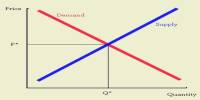Labor is the human component of the manufacturing process. The division of tasks in any economic system or organization so that participants can specialize is referred to as the division of labor. Individuals, organizations, and nations are gifted with or acquire particular capabilities, and they either create alliances or trade in order to benefit from the capabilities of others in addition to their own.
Adam Smith established the concept of ‘Division of Labor’ in his book ‘An Enquiry into the Nature and Causes of National Wealth.’ It entails splitting the manufacturing process into distinct and various component processes and allocating each component to a laborer or a group of laborers who are specialists in that particular activity.
Complete success of division of labor depends on the following factors:
(1) Wide Market:
Economists believe that the Division of Labor will function successfully and that its success will be dependent on a large market. Division of Labor will not develop much if there is a tiny market. Division of labor is most commonly found in large factories where goods are produced on a huge scale. Only then can the job be divided into separate processes and assigned to a distinct set of workers.
(2) Large Scale Production:
The items must be produced on a huge scale for the Division of Labor to be a complete success. When there is large-scale production, more laborers will be employed, and the Division of Labor will be possible in a good method.
(3) The Quantity of Capital Available:
A certain amount of capital is required for a successful and improved Division of Labor. A lack of capital and money that is not available on time may assist the corporation in avoiding the Division of Labor.
(4) Nature of Demand:
Some industries are so complex that it is impossible to break work into distinct and separate processes. The scope of Division of Labor is likewise limited in this case. The ability to break up output is critical for the Division of Labor.
(5) Organizing Ability:
The division of labor refers to the employment of a large number of workers in a single factory. Handling them properly and assigning a suitable duty to each worker necessitates a high level of human-nature judgment. As a result, the entrepreneur must be able to organize large-scale production.
(6) Spirit of Co-operation:
If the workers are unwilling to cooperate. They are squabbling and cannot work together peacefully; division of labor is out of the question. There must be a spirit of cooperation, a spirit of compromise, and a spirit of teamwork. Division of Labor cannot be implemented unless there is an attitude of giving and taking.
(7) Laws of Increasing Returns:
Because production will be on a big scale where the law of growing returns dominates, the opportunities for the Division of Labor are larger.
(8) Availability of More Labor and Capital:
The concept of division of labor requires large-scale production. A large number of workers are required. Further division of labor and the use of machines go hand in hand; significant sums of money will have to be spent on machinery. If the necessary manpower and capital are not available, the Division of Labor cannot be extended or implemented to the appropriate extent.
(9) There should be Development of Means of Transport and Communication:
Transport and communication methods must be created for the Division of Labor to succeed. If transportation infrastructure improves, raw materials will be more readily available, and finished commodities will be able to be shipped outside for sale.
















